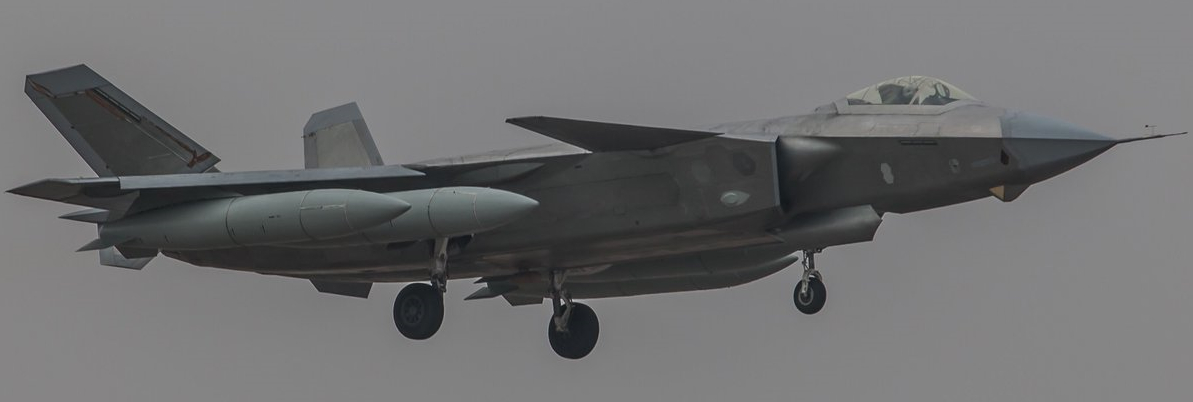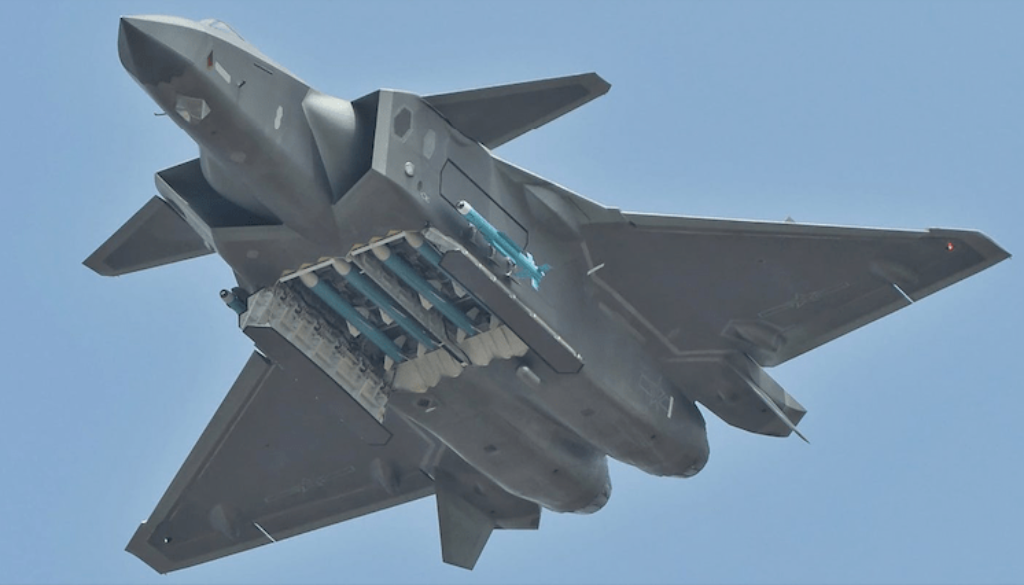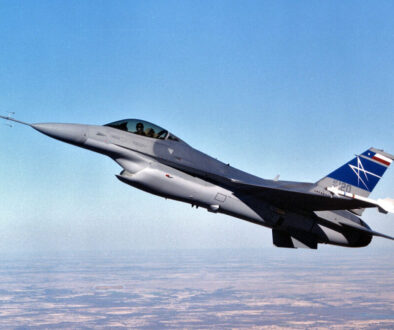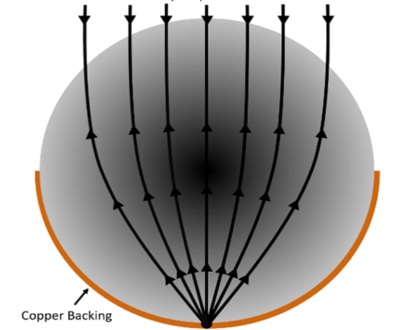J-20: China’s “Mighty Dragon”
The Chengdu J-20 “Mighty Dragon” is a twinjet all-weather, stealth, fifth-generation fighter aircraft developed by China’s Chengdu Aerospace Corporation for the People’s Liberation Army Air Force (PLAAF). The J-20 is designed as an air superiority fighter with precision strike capability. The aircraft has three notable variants: the initial production model, the revised airframe variant with new engines and thrust-vectoring control, and the aircraft-teaming capable twin-seat variant.
Configuration
The aircraft is a twin engine, delta canard, long and blended fuselage, chiseled nose section, frameless canopy, diverterless supersonic inlet (DSI) intakes.
All-moving canard surfaces with pronounced dihedral are placed behind the intakes, followed by leading edge extensions (LERX) merging into the delta wing with forward-swept trailing edges. Leading edge extensions and body lift are incorporated to enhance performance in a canard layout. This combination generates more lift compared to an ordinary canard delta or an equivalent-sized pure delta configuration. This combination allows the use of a smaller wing, reducing supersonic drag without compromising transonic lift-to-drag characteristics that are crucial to the aircraft’s turn performance.
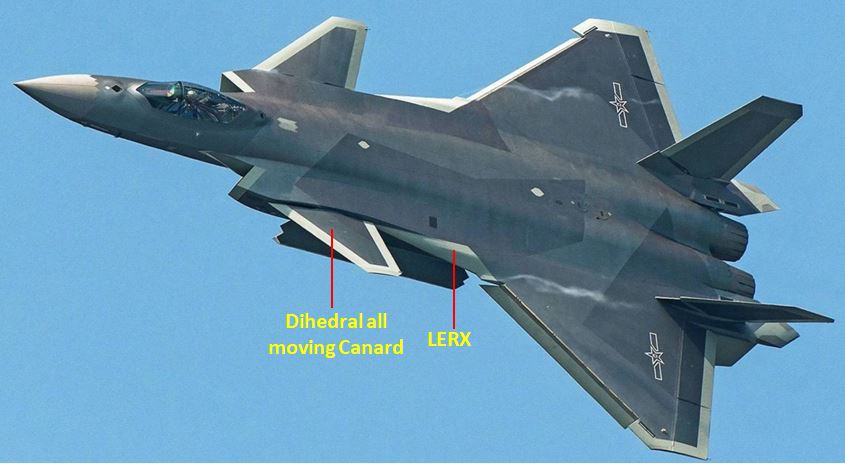
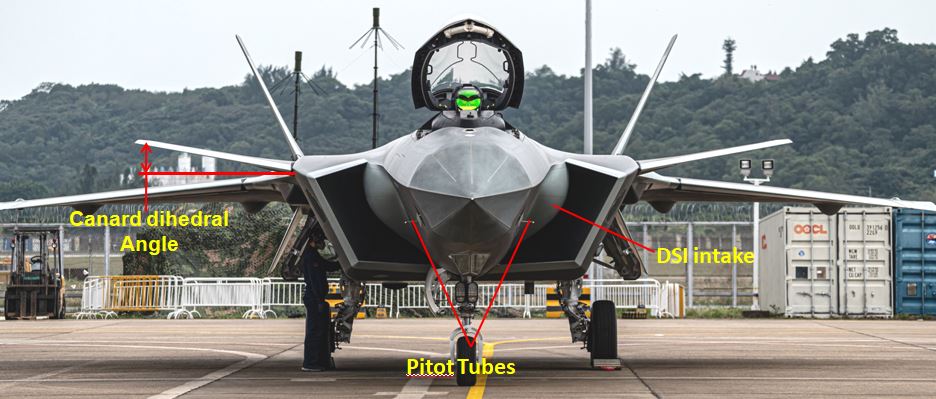
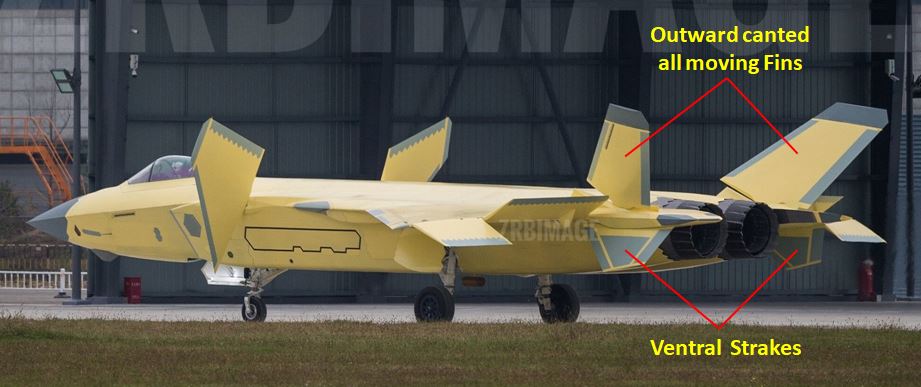
Avionics
Primary radar
Although official information on the type of radar that J-20s use has not yet been released publicly, J-20s is believed to use Type 1475 (KLJ-5) active electronically scanned array (AESA) radar with 1856 transmit/receive modules. However based on the nose cross-section of the J-20 and known data about a single transmit/receive module, J-20s likely contain 2000–2200 transmit/receive modules giving greater power and performance.
As of now there is no information regarding capabilities such as Range, Low probability of intercept (LPI), differing modes available, peak power, electronic counter counter measure (ECCM) capabilities, material used, i.e., GaN or GaAs.
EOTS
All airframes of the J-20 from the 2011 prototype have featured a chin mounted, faceted window for an electro-optical/infra-red sensor capable of search and track functions. The configuration of this sensor is similar to the Electro Optic Targeting System fairing on the F-35’s chin, however J-20’s appears to be less “deep” and “longer” than the F-35’s EOTS. The configuration of the faceted windows on J-20’s sensor also appears different to F-35’s EOTS.
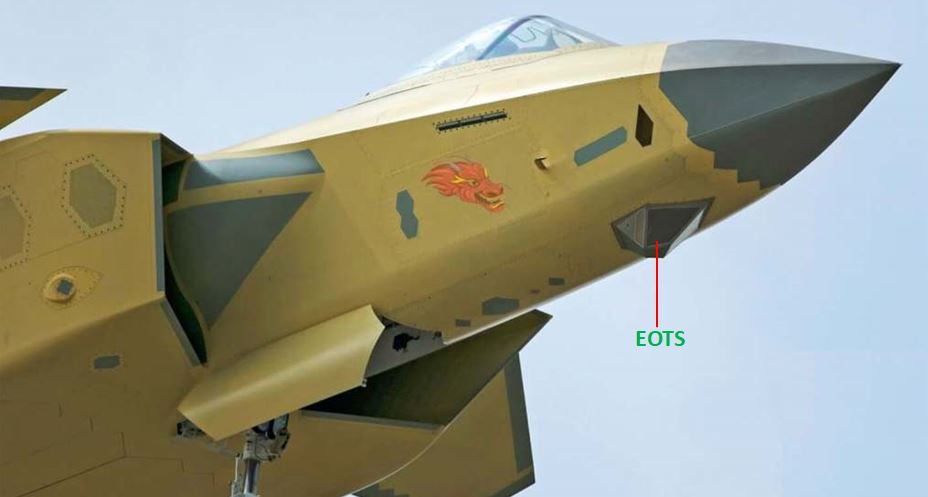
The F-35 EOTS is capable of air to air tracking and targeting as well as air to ground tracking and targeting, with the air to ground function being a key part of F-35’s overall strike fighter capability. The air to ground tracking and targeting function includes laser spot tracking and laser designation to assist in the guidance of precision guided munitions. F-35’s EOTS features many air to ground capabilities such as laser spot tracking and laser designation, which J-20’s EOTS may lack since it seems to be designed for air superiority role.
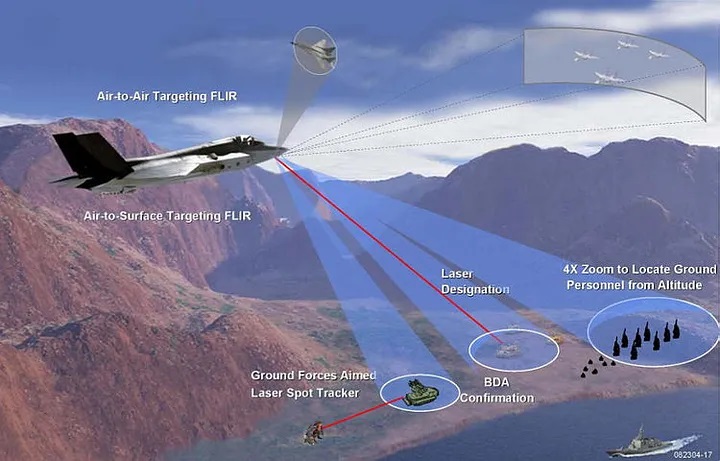
A private Chinese aerospace company called Beijing A-Star has offered a range of “EOTS” products, with specifications and performance details, as well as illustrations depicting their products equipped aboard both J-20s and FC-31s, however at present there is no evidence to suggest that the equipment has been installed on the aircraft.
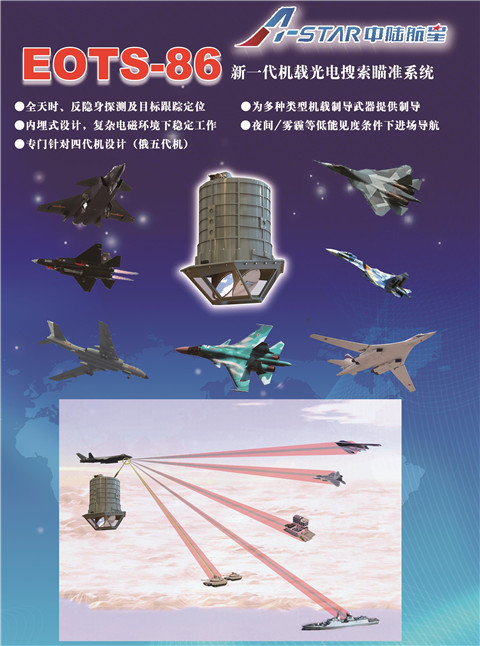
Electro Optic Passive Detection System
The J-20 is equipped with six distinct, window apertures around the aircraft; these house the electro optic sensors. The apertures are arranged in the aircraft in such a way so as to provide three hundred and sixty degree spherical coverage around the aircraft, and the placement and configuration of the apertures are similar to the placement of the six apertures for the F-35’s AN/AAQ-37 Distributed Aperture System (DAS).

The F-35’s DAS provides three basic categories of functions in every direction simultaneously:
- Missile detection and tracking (including launch point detection and countermeasure cueing)
- Aircraft detection and tracking (situational awareness, infrared search and track (IRST) and air-to-air missile cueing)
- Imagery for cockpit displays and pilot night vision (imagery displayed onto the helmet mounted display, i.e., the DAS allows the pilot to essentially “see” through the DAS apertures seamlessly, such that they can even “look through” the floor of the aircraft to what is occurring immediately below the aircraft.)
It is unknown how many of the capabilities of F-35’s DAS will also be present onboard J-20’s EO PDS.
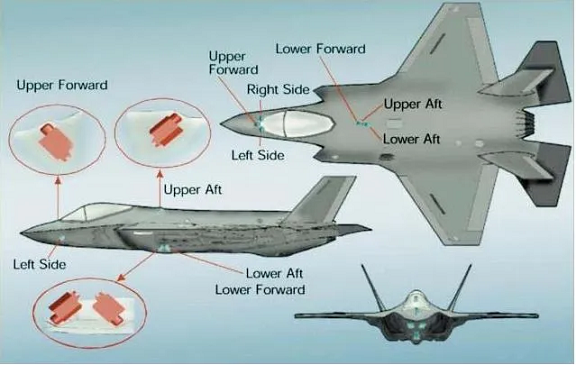
ESM suite
An advanced Electronic Support Measures suite is an essential part of a modern fighter aircraft’s mission avionics. An ESM suite helps to detect, identify, locate, record, analyze and even geolocate sources of electromagnetic energy, which for a fighter aircraft typically means an opposing force’s radar system. Modern ESM suites have grown in capability and complexity from mere warning systems to alert a pilot when their pilot was possibly being targeted by radar, to being capable of simultaneously geolocating multiple sources of radar emissions in real time and automatically activating counter measures, targeting solutions and cueing weapons.
Such suites are immensely difficult to identify, and may only sometimes be visible as small, low profile conformal antennae around an aircraft. Multiple sites that could hold small conformal antennae have been identified on J-20 through picture analysis, and there are likely multiple other sites with antennae which are not outwardly visible. Either way, it is certain that J-20 will be equipped with an ESM suite of some kind, and if trends for other fifth generation ESM suites are anything to go by, it is likely the Chinese Air Force would have similarly high requirements for J-20’s ESM suite.
Datalinks
High bandwidth datalinks to provide communication and coordination and transference of information between friendly aircraft, ships and other combat forces are a vital feature for fifth generation fighter aircraft. The J-20 will likely be equipped with a datalink that could at least receive the Chinese military’s Joint Service Integrated Datalink System (JSILDS), a system which is said to be similar to the Link 16. It is possible that J-20 may also feature advanced iterations of other datalinks, such as an equivalent to the Multifunction Advanced Datalink of the F-35, or the F-22’s Intra Flight Datalink, to provide effective stealthy and secure communications between aircraft which JSILDS may be incapable of.
Cockpit
The aircraft features a fully-digital glass cockpit with one primary
large color liquid-crystal display (LCD) touchscreen, three smaller auxiliary
displays, and a wide-angle holographic heads-up display (HUD). The aircraft is
fitted with a helmet-mounted display (HMD) system, which displays combat
information inside the pilots’ helmet visor and facilities firing missiles at
high off-boresight angle.
Engine
The prototype and initial aircrafts were powered by an improved Lyulka-Saturn AL-31 variant, the AL-31FM2 developed by Salyut. The engine has a maximum thrust of 142.2 kN (31,970 lbf).
The J-20 is powered by Shenyang WS-10C, an afterburner turbofan engine manufactured by Shenyang Liming Aircraft Engine Company. The WS-10C will serve as an interim engine before the adoption of the more powerful Shenyang WS-15. WS-10C has a thrust of 142 kN, a thrust-to-weight ratio of 9.5 providing necessary propulsion for J-20 to supercruise, and is fitted with serrated afterburner nozzles for enhanced rear-aspect stealth.
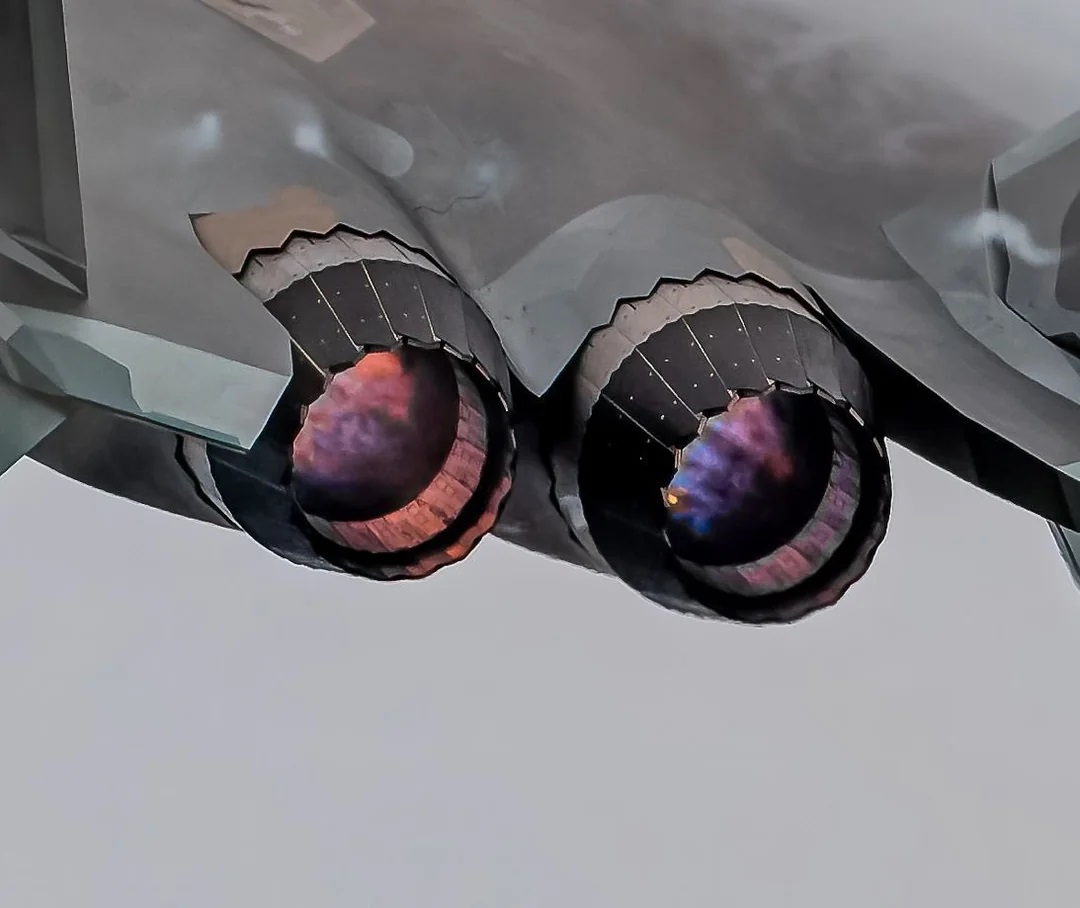
It has been reported that prototypes of the WS-15 engine were capable of producing at least 36,000 pounds of thrust with afterburner, with the ultimate aim of achieving a thrust rating of 40,000 pounds. The WS-15 in its current form features a standard nozzle without thrust vectoring nozzles. The key advantage it brings is the increased thrust, which will propel the J-20 into the elite group of current fighters that can supercruise well above Mach 1. This would confer it an ability to get places faster, as well as likely increase its ceiling.
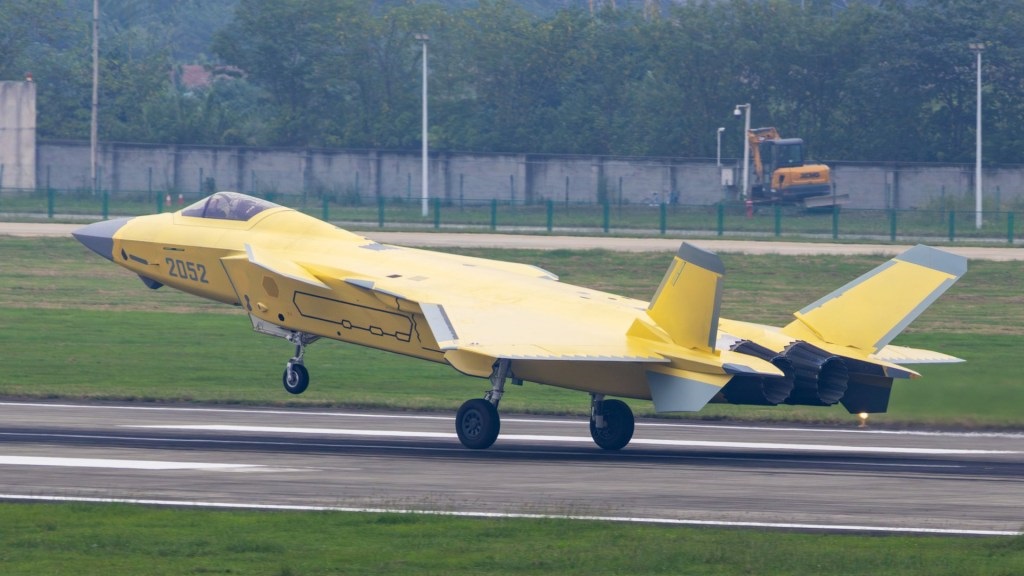
Armament
The J-20 has three internal concealed weapons bays, one in the underbelly and one each on the side of the engine. The main weapon bay is capable of housing both long-range air-to-air missiles (AAM; PL-15 – PL-21) and precision-guided munitions (PGM; LS-6/50, LS-6/100,FT-7). The main weapon bay can house four medium/long-range AAMs while the side bay houses one short-range missile in each.
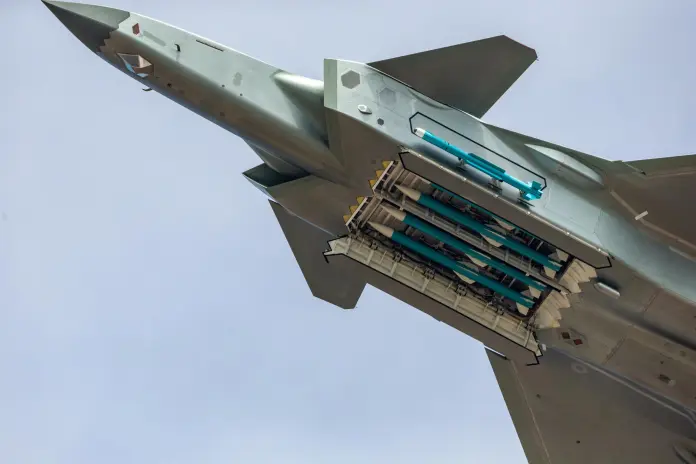
The two smaller lateral weapon bays behind the air inlets are intended for short-range AAMs (PL-10). The bay has a mechanism where rounded semi-circular launcher rails roll out carrying a missile. These side bays allow closure of the bay doors prior to firing the missile, enhancing stealth and allowing the missile to be fired in the shortest possible time.
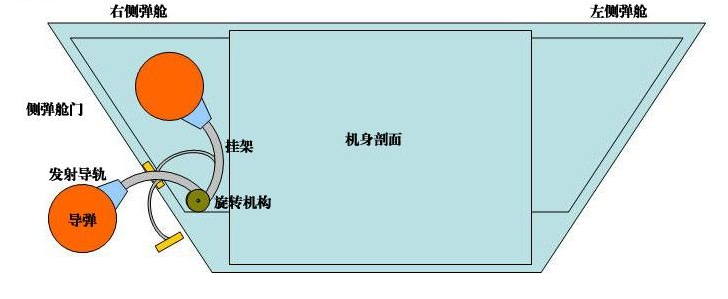

The J-20 lacks an internal autocannon or rotary cannon.
The wings include four hardpoints for auxiliary fuel tanks to extend the ferrying range. External fuel tanks negatively impact the J-20’s low observable (stealth) qualities and maneuvering performance, it is likely that they can be jettisoned along with their pylons in a similar manner as the F-22. This allows the aircraft to recapture a large degree of its low observability.
